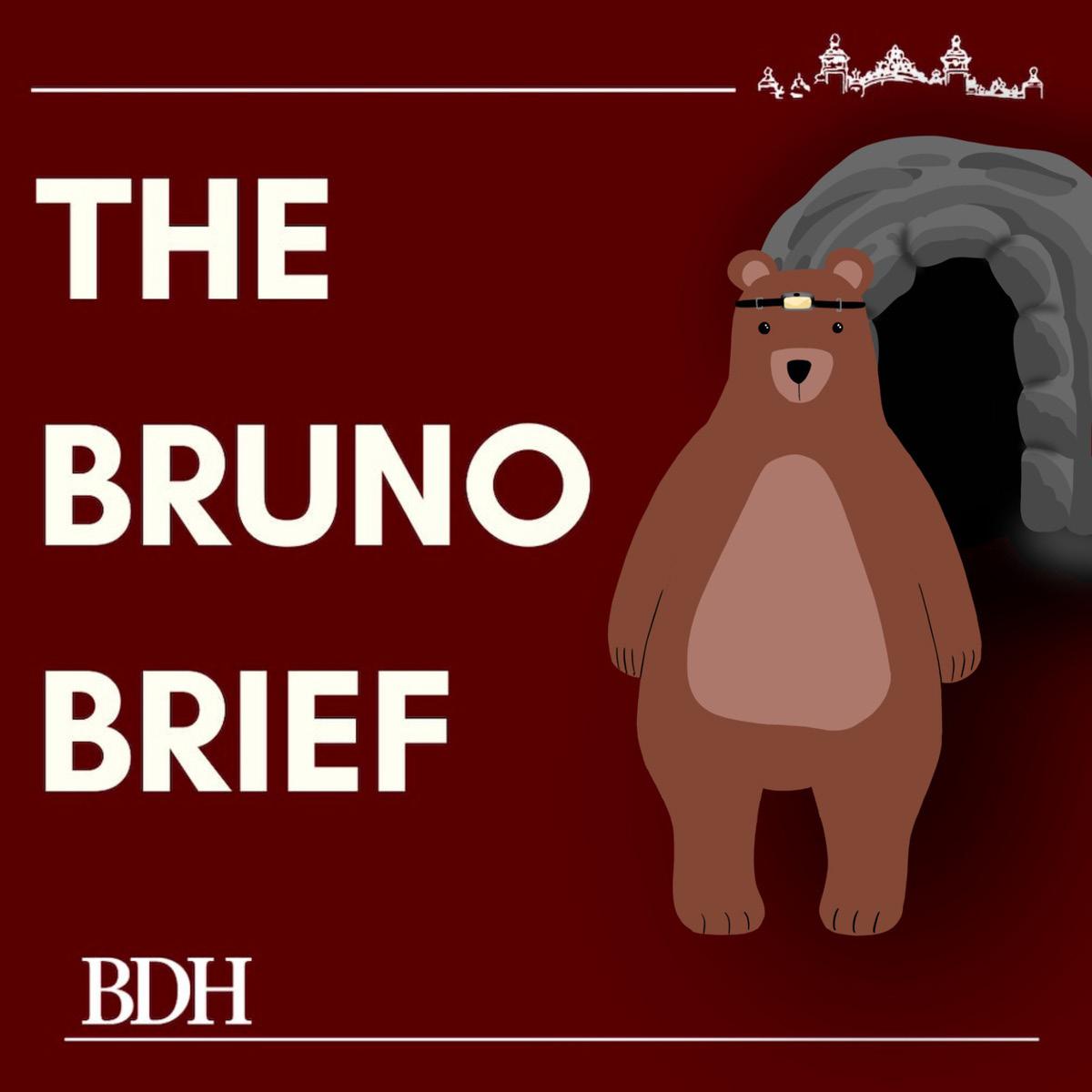U.athletes sue Ivies over lack of scholarships
Students
BY JULIA VAZ METRO EDITORA class action lawsuit filed Tuesday by current and former Brown basketball players Grace Kirk ’24 and Tamenang
Choh ’21 MPA’22 alleges that Ivy League schools violate antitrust laws by denying student athletes athletic scholarships and compensation for their services.
The lawsuit claims that the alleged price-fixing “Ivy League Agreement” has “anticompetitive effects, raising the net price of education that Ivy League athletes pay and suppressing compensation for the athletic services they provide to the University Defendants.”
According to Michael McCann, director of the Sports and Entertainment Law Institute at the University of New Hampshire, the plaintiffs’ argument is that “while Ivy League schools compete (with each other) in numerous ways, such as in pur-
UNIVERSITY NEWS
suit of top faculty, grants or media attention,” they agree to not compete when recruiting college athletes by failing to offer specific scholarships and reimbursements for education expenses.
According to the complaint, this violates the Sherman Antitrust Act of 1890, which protects “trade and commerce against unlawful restraints and monopolies.” The Sherman Act “prohibits competing businesses, including colleges, from colluding in ways that harm competition,” Mc -
Paxson elected to board of college advocacy group
Paxson will begin three-year term for American Council on Education in April
BY KATIE JAIN SENIOR STAFF WRITER

The American Council on Education announced the election of University President Christina Paxson
P’19 P’MD’20 to its board of directors for a three-year term March
2, according to a University press release. Paxson was elected to the board of the organization — which is composed of more than 1,700 colleges and universities — during a recent ACE business meeting, according to a press release from the group.

Founded in 1918, ACE serves as an advocacy organization for higher education institutions in the U.S, according to their website, lobbying and producing research to “improve equity, expand access to our colleges and universities, and diversify the higher education leadership pipeline.”
“It’s a privilege to serve an or-
Pre-college program offers full scholarships to PPSD students
ganization with a strong record of working across all sectors of higher education to shape policy and support innovation,” Paxson wrote in an email to The Herald.
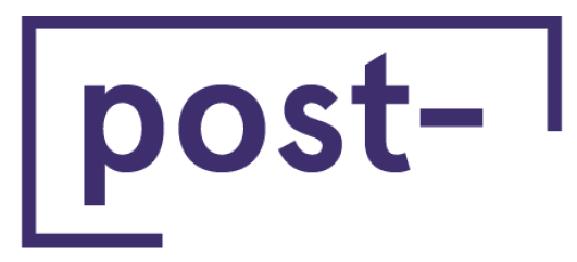
Paxson and the other presidents and chancellors elected to the board will begin their terms after the organization’s annual April meeting in Washington, D.C., according to the ACE press release.
The board, composed of 24 elected members and 13 representatives from designated organizations, will be chaired by Linda Livingstone, president of Baylor University and the current vice chair of the board.
Paxson will join the board along with the presidents of the University of Washington, the University of Nebraska system, Swarthmore College and a number of other colleges for a term ending in September 2026.
“I look forward to working with (Livingstone) and other members of the board to confront the challenges and opportunities facing educational institutions,” Paxson
Jack Seppings ’25 joins Great Britain in World Baseball
Cann wrote in an email to The Herald.
The lawsuit builds on the 2021 National Collegiate Athletic Association v. Alston Supreme Court case, which ruled that colleges that “join hands to prevent any individual college from paying their athletes for education-related expenses” violate antitrust law, McCann wrote.
“The restrictions on price competition that lie at the heart of this case are analogous to other restrictions
UNIVERSITY NEWS
UNIVERSITY NEWS
Students rally for changes to U. admissions policies
Rally calls for testoptional admissions, end to legacy preferences
BY NEIL MEHTA UNIVERSITY NEWS EDITOROver 100 students gathered on the Main Green Thursday, calling for the University to end legacy admissions and move to a test-optional admissions process.
“What matters? Race matters,” the students shouted.
The rally, led by Students for Educational Equity and the Undergraduate Council of Students’ Diversity, Equity and Inclusion Committee, was organized ahead of the Supreme Court’s expected decision to overturn affirmative action later this year.
“Our diversity is our strength,” said Niyanta Nepal ’25, SEE co-president, to the crowd at the rally. “Affirmative action is a
critical tool in this effort, as it allows us to level the playing field for historically underrepresented communities.”
In the possible absence of affirmative action, Nepal called for the University to permanently commit to test-optional admissions, a policy that has been temporarily in place for prospective undergraduates since the 2020-2021 admission cycle.
Nepal also called for the University to abolish legacy admissions, which allows admission officers to consider whether an applicant’s family members attended the University. The policy “has no place in our university,” she said.
Legacy admissions rob “seats from systematically marginalized populations,” according to former SEE co-President Zoë Fuad ’23.5. “It is far past time to end this archaic policy.”
Speakers such as SEE co-President Jada Wooten ’24 highlight-
Bolsen ’26 wins Jeopardy! tournament
BY SOFIA BARNETT UNIVERSITY NEWS EDITORJustin Bolsen ’26 has been keeping a six-figure secret for a month.
On Thursday night, the pre-taped final episode of Jeopardy!’s high school reunion tournament aired. Bolsen emerged victorious, winning the $100,000 grand prize and a spot in the Jeopardy! Tournament of Champions this fall, where he will be the youngest player in the game, according to a Jeopardy! press release.
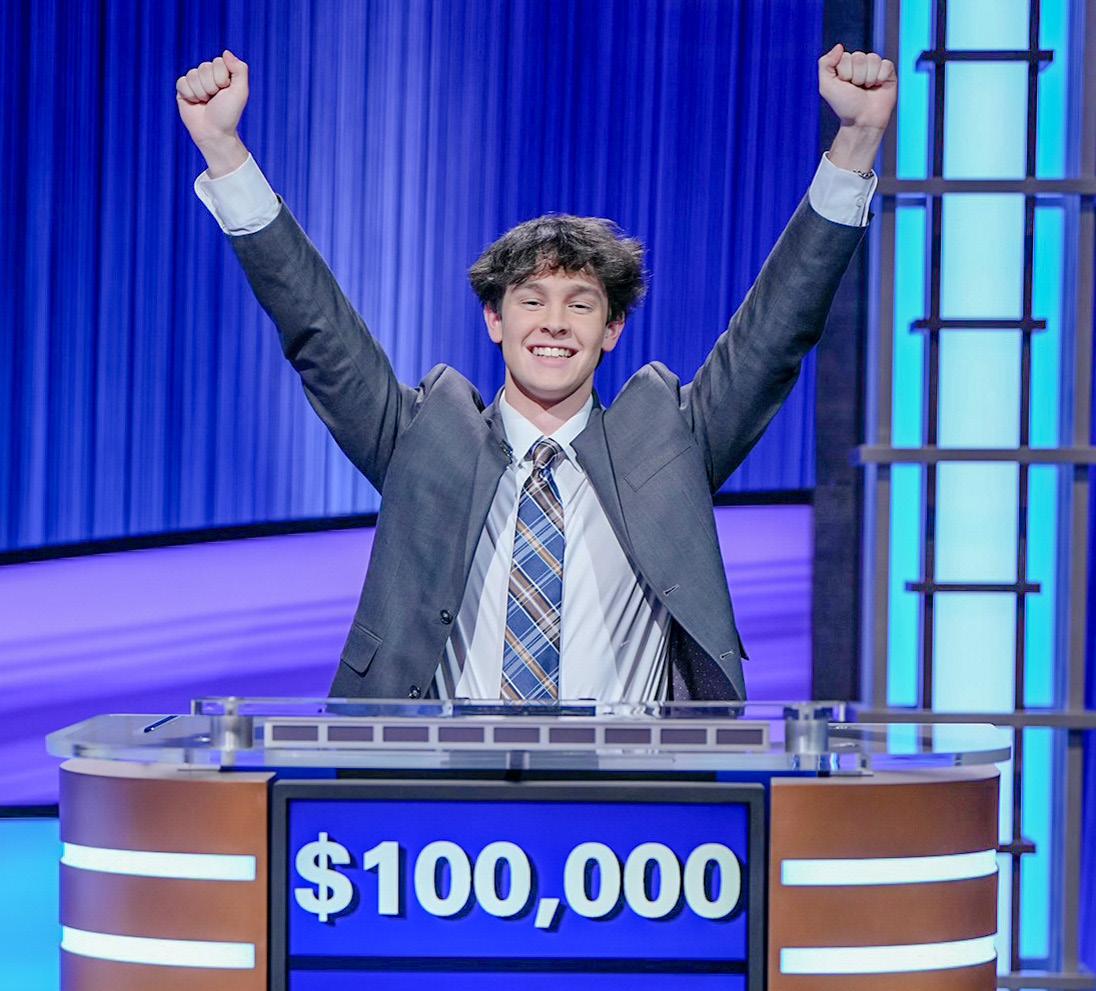
Bound by confidentiality until the episode aired, Bolsen told The Herald that obscuring his victory from family and friends wasn’t easy — though it was still less of a challenge than during his first run on the show in 2019.
“It’s been crazy keeping this from everyone for a month,” he said. “I’ve even kept it from my parents.”
“People have been trying to get it out of me since I’ve been back, but I’ve been misleading them and trying to throw them off the whole time,” Bolsen added.

Thursday’s episode was part of a two-round tournament finale with Bolsen, Jackson Jones, a Vanderbilt University junior and Maya Wright, an Emory University senior. The tournament’s victor was determined based on which student had the highest combined score from both games.
Bolsen was down by roughly $10,000 at the end of the first part
of the finale, which aired Wednesday night.
“It was crazy. I missed the final Jeopardy! question,” he said. “It was a state capital question: What is Dover?”
Bolsen’s margin of victory over Jones in Thursday’s game was just $363, which hinged on a successful
claim Ivy League breaks antitrust laws by not offering athletic scholarships
First-year takes home $100,000, advances to Tournament of ChampionsCOURTESY OF JEOPARDY PRODUCTIONS, INC. Thursday’s game was the second part of a two-round tournament finale that featured Justin Bolsen ’26, Jackson Jones and Maya Wright. DANA RICHIE / HERALD
boyhood and me
grieving girlhood and finding truth
by Audrey Wijono illustrated by Joyce Gao IG: @orangefrog_artcw: homophobic slur, mention of gender dysphoria
There’s a photo up on my fridge back home, so old it’s grown yellow by the edges. I try not to draw attention to it when people come over, but it’s always to no avail; it’s so uncharacteristic that it sticks out like a sore thumb.
I’m young in the picture, probably no more than three or four. I was a round kid, and it shows: my cheeks are full and limbs soft, baby fat folding into itself. I’m Cinderella, adorned in flowy, shimmery fabrics. The dress itself is much too large for me–I’m drowning in cloth and glitter, layers enveloping my figure. And yet, in some odd way, it fits just right. Even under the weight of it all, I’m grinning, carefree.
Beside me are two girls, dressed in the same extravagant costumes. Their arms are linked with mine. And they, too, are smiling in that same unrestrained way, traces of laughter still evident on their faces.
We slot together in our girlhood. And it’s natural, as all friendships should be.
For a time, I would have said gender was innate.
chinese summer, american camp ecce
homo, friends
by Daniel HuDear Pastor B,
Of you I remember almost nothing. I remember a speech about divine grace you gave before we watched Kung Fu Panda at Bible camp. I remember your spindly fingers and the bumpy blue-grey veins that pulsed down your forearms and the way you walked with a thumping arrhythmic gait. I remember the call-and-response you used to get us to quiet down: you sang out bum bum buh-dum bum and waited for us to sing back: bum bum! I remember your white hair and your hawkish blue eyes and how odd I thought it was that you, a white man, were the one preaching to a congregation full of Chinese children.
The rest of you is captured only in the haziest impressions. I can hardly recall a thing you told me about God. These shattered mirror-glass memories are all I have left of you. Half of my life was spent going to Bible camp and Sunday school but I confess to no longer being Christian. I’m not sure that I ever was.
I write this not as an apology, because I have nothing to apologize for. I write this not as a means to reach you, because I know how unlikely it is that you will ever read this. I write this for myself....
In those early years, I was a girl, and unmistakably so. I did everything right: I wore bows in my hair and spun around in pleated, delicate skirts. I wore jelly sandals and Mary Janes, grew out my hair, and begged my parents for everything a girl should: plushies, dollhouses, jewelry.
I played dress-up with my friends with an ease I knew only in childhood.
But that kid, that baby-blue Disney Princess in the making–was that really me?

And if so, where did she go?
*
My mother was fiercely protective as I was growing up. Nowadays, she tells me that she must have sheltered me a little too much; she rarely, if ever, let me out of her sight. I didn’t hang out with many kids outside of school. And when I did, it was usually with my cousins.
My older cousin quickly became my idol— perhaps by proximity. He’s not so much older than I am; two years is nothing to me now. But back then, when all I knew was the confines of my youth, there were worlds between the ages of seven and nine...
“I’d like to believe that endings do not erase beginnings. I’d like to believe in a world that, despite blustery winters, turns snow into sunlight. So I’ll just live as if those things are true.”
—Kaitlan Bui, “Something like the Opposite of Loneliness”
“I guess, in the end, I am always dreaming of a pale purple sky, a cream mercedes, IHOP French toast on my tongue. An endless morning.”
—Kyoko Leaman, “IHOP French Toast” 02.19.21
puerto rico
on mom's boxes to rhode island
by Nélari Figueroa-TorresThe mailroom worker calls my name like they've never heard a name like it before, because they've never heard a name like it before. I know it's a box from my mom; her big black Sharpie font says her name and mine. For a second, we are together. All the times we have hugged and every time we could not.
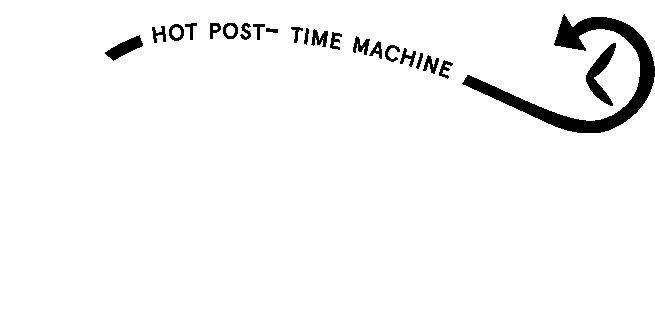
I put the box in the bag that she told me to bring because she said I would need it. “Que pena que vives tan lejos,” I remember her saying as the smooth tunes of Samara Joy aligned with my steps.
I use the scissors she bought for me when I moved in to rip through the five layers of tape. Because, as her voice reiterates in my head, “USPS always beats up the boxes.”

There's always tissue paper and two handwritten notes: one from her and one from my niece. Those are the contents I value most. This time there is bubble wrap. As I peel back the layers I realize it is a mug, bright with color. It comes with a spoon I won’t use because I don't add sugar to my black coffee.
The mug says “Old San Juan, Puerto Rico.” There's a vibrant pattern of buildings from this area, one on top of the other, and a Puerto Rican flag painted on the centered door...
i don't want a souvenir from
ode to female friendships oh,
how i love being a woman
by Managing edstwinship
by Kimberly LiuThe most transcendental part of any relationship, for me, is self-recognition through the other. It establishes, in one irrefutable proof by example, the assertion that we are all one, intertwined in our struggles and pains as we are in our joys and exaltation.
I met my ride-or-die-twin-flame while we were both coveting the role of lead singer in our 7th grade music class. The song was “Part of Your World” from The Little Mermaid, and needless to say, we were mortal enemies...
dance party for 2
by Kathy GonzalezWhen we were six years-old, Emely and I would host the most extravagant dance parties. Anyone who was anyone was there—her worn-down teddy bear, the lopsided Little Mermaid pillow, and the two of us. We pushed her leather sofa back against the wall to broaden the dance floor, revealing leftover Lindt chocolate wrappers we'd snuck out of her pantry the night before. As I browsed through dozens of cable radio channels on the TV, she would fill up our water bottles and stretch...
you know?
by Joe MaffaIn the post- office, my most supportive, nurturing, and healing friends Aditi, Alice, Kathy,

ARTSLIFESTYLE & CULTURE
Kimberly, and Tabitha know something that I don’t. Maybe it’s how to use an em dash. But that doesn’t stop me from trying—despite being ratioed by their endless grammatical wisdom. Maybe it’s why the ethmoid looks vaguely labial. Command+T, “ethmoid,” Command+T, “ethmoid, pussy bone?” Command+W... not really strangers
by Alice BaiMy summer in Memphis was thick with sweat and hazy Mississippi air. I didn’t know anyone there, not really, and I had braced myself to spend my free time romanticizing solitude and practicing (or just playing at) adulthood.
What I found instead were friendships with women who were willing to share. We shared car rides, and cheesecake, and lunch swipes, and stories about what we cared about and how we thought the world might perceive us...
girlish charm
by Tabitha LynnMiddle school sleepovers were the pinnacle of my existence. Planned weeks in advance, they were my first real taste of independence.
My mom can drop me off if your mom picks you up.
We can stay in the basement and order pizza. I have to leave at 9am for my soccer game...
the glitch generation
the beauty of digital loss and ephemerality
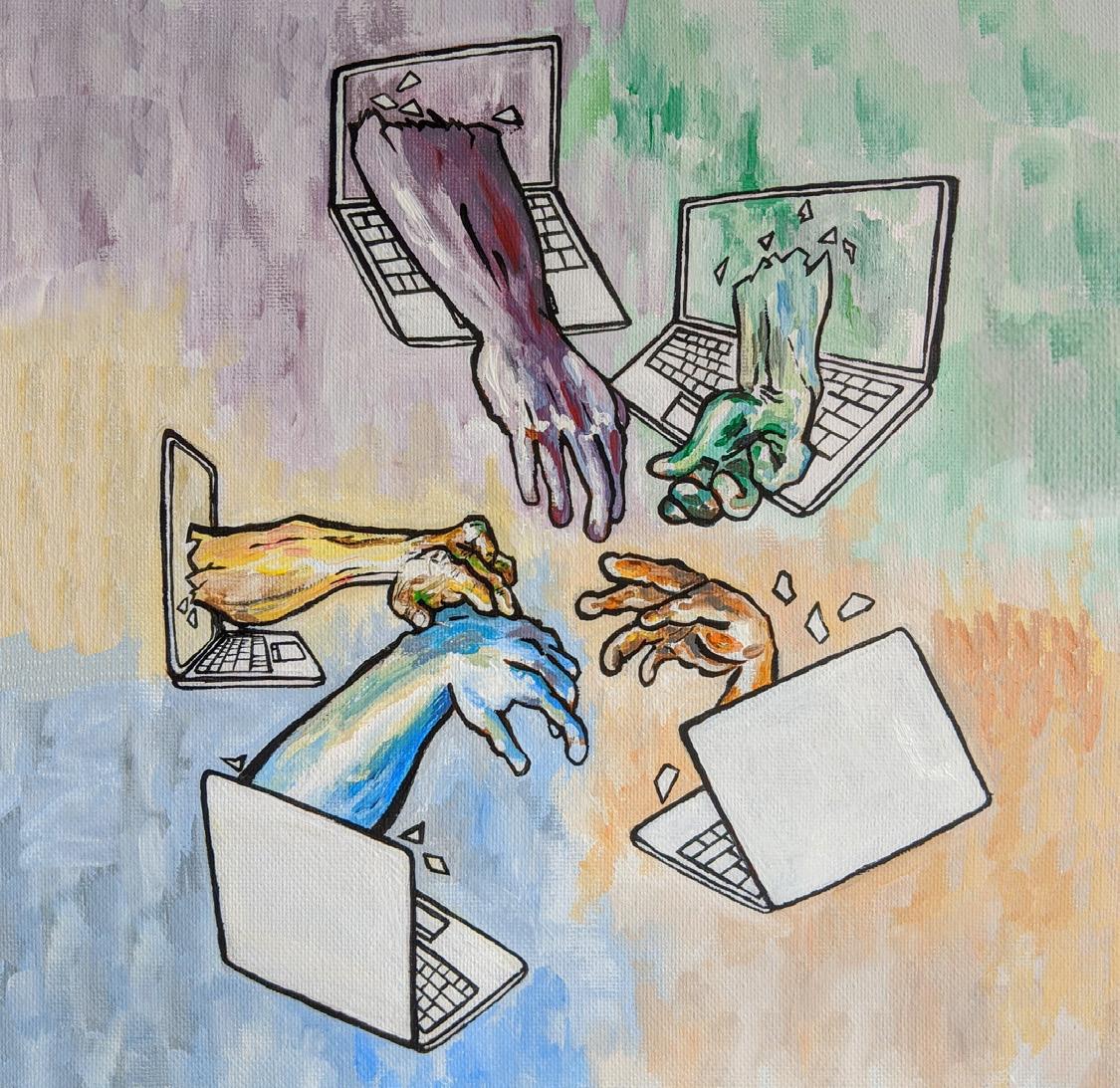 by Dorrit Corwin
by Dorrit Corwin
Illustrated by Icy Liang
June 6, 2008 was the first time I saw an iPhone. I was sitting in a Jewish deli next to the hospital where my mother was in labor with my brother. At the time, I only knew the flip phones I saw in movies and the Blackberries my parents used, which solely piqued my interest when they let me borrow one to play Brick Breaker. But this new phone had everything. I marveled at its camera, an app I could click on with my finger, that opened and closed with a swirling motion. Instead of just Brick Breaker, you could put whatever games you wanted on it by downloading them from an “App Store.”
Gen Z is the first generation to grow up with
smartphone technology at our fingertips; the technology grows with us. People born at the beginning of the millennium aren’t young enough to have been iPad babies, but by middle school, we were hooked on every app from Tiny Wings to Twitter. Big tech companies at that time were just beginning to discover how the interest they created could transform into addiction. This contemporary tech was new, so we experienced many glitches; we’re essentially a generation of guinea pigs.
I joined Snapchat in 2011, the year it was created, and Instagram soon after, without even having the term “social media” in my vocabulary...
“I think I’ve decided to skip the gaslighting and go straight to manipulation.”
“I had to dress my best because today we got a gecko (his name is beef chili fish).”
Seasons
1. 32 of Survivor
2. Fall
3. Everything but the bagel
4. Tajín
5. El Niño (or La Niña because its women’s history month)
6. -al depression
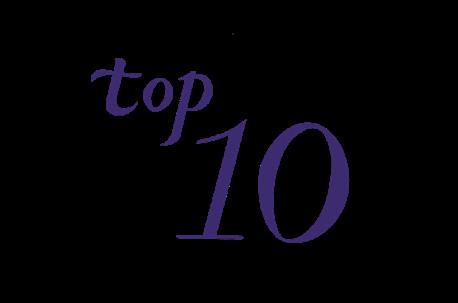
7. Greetings
8. Virgo
9. Donna Summer
10. Cuffing
the silver lining to being ordinary embracing
normalcy in all its forms
by Samiha KaziThe drive back down to Providence crosses between two of my own realities as it crosses state borders. Every single time I embark on the journey back to campus, the hour-long car ride is always accompanied by a torrential downpour. The kind of rain that loudly pounds against the windshield and consumes all corners of your mind. The sort of drive where I momentarily revert into my five-year old self, scared of the darkness and bombarding droplets that seemed to surround us. My dad likes to joke that it’s the universe’s way of trying to keep me at home; sometimes I think he is absolutely right. And it makes the return just a little bit harder each time.
Gone are the pink walls and scratched up wooden floors from my childhood bedroom, and I am once again surrounded by four concrete walls where my photos dangle from poorly attached Command strips. I don’t even bother unpacking the excessive amount of clothes from my month at home. I yank my iPad from my backpack and climb right into bed, ignoring my duffel bag sitting in the corner. I would do anything to stay in the safe haven I had built for myself for the past month and keep the reality of the looming semester at an arm’s distance away.
I didn’t want to be on campus. After weeks of waking up in an appropriately-sized bed, my mother happily cooking me meals, and driving around aimlessly with my hometown friends, I couldn’t fathom diving right back into the spring semester...
‘The Listening Takes’ contemplates role of women in film industry
Elisabeth Subrin’s exhibit on display at List Art Center until June 4
BY NED KENNEDY STAFF WRITERThe Brown Arts Institute held a reception celebrating the opening of its latest exhibition, award-winning filmmaker Elisabeth Subrin’s “The Listening Takes,” on Feb. 9. The exhibit, funded by BAI and on display at the List Art Center’s David Winton Bell Gallery, presents three portraits of French actress Maria Schneider through an immersive film installation. The exhibit will be on display until June 4.
When creating “The Listening Takes,” Subrin took inspiration from a 1983 French TV interview with Schneider in which she refused to discuss her role in Bernardo Bertolucci’s 1973 drama “Last Tango in Paris.” While on set for the film, Schneider was subjected to filming a rape scene without previous knowledge of its graphic nature. For years following the film, Schneider struggled with depression and addiction.
In the 1983 interview, Schneider “articulates her perspective as a woman within the film industry, (and) reveals a devastating prescience about the ways women are defined within and beyond cinema,” BAI Director of Exhibitions and Chief Curator Kate Kraczon wrote in an email to The
wrote.
“Our board is responsible for all of the traditional governance functions that a board would be responsible for (including) audit, compliance, finance and nominating,” said ACE Vice President and Chief of Staff Jessie Brown ’02. “The board is also really involved in helping set the strategy of the organization and thinking about its priorities.”
“When we hear from the board, it helps shape our policy … (and) programmatic agenda,” Brown added. The board’s recommendations help identify new programs to implement
Herald.
Subrin’s installation consists of a series of wall segments on which three videos play. Each of the videos display a reenactment of the interview, performed by one of three acclaimed actresses: Manal Issa, Aïssa Maïga and Isabel Sandoval. The recordings play simultaneously; as one actress speaks, the other two listen.
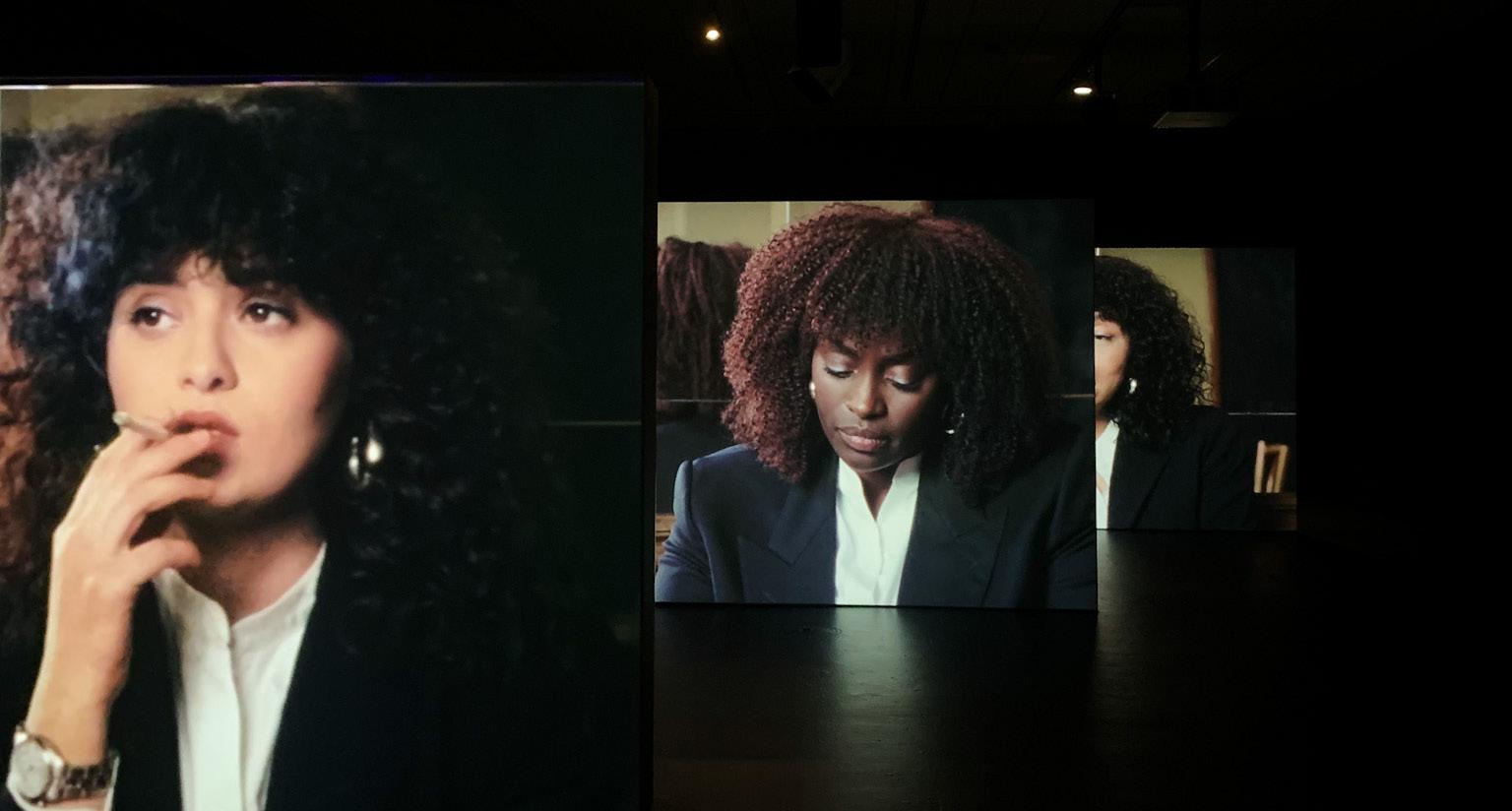
The installation is “an immersive, circular experience,” Subrin said. “With 13 channels of sound and nine speakers, you’re moving through the space in different ways.”
“You get a sense of this chorus of women listening and speaking,” she added. “There is an intimacy in those spaces between the screens.”
In creating “The Listening Takes,”
or other “major programs … to consider rethinking for this modern era.”
In electing new board members, ACE considers the diversity of institutions represented, along with their commitment to ACE’s work of promoting “good policy” and pushing “institutions toward innovative practices.”
Brown described the process of choosing official nominees as a “two-factor analysis.” Both diversity of institutional demographics — including type and geography — along with the individual board nominees’ interest in and engagement with the ACE’s work “to promote good policy and push institutions toward innovative practices” are considered, she
Subrin sought to reclaim the agency of Schneider — who has often been painted as a tragic figure whose life was ruined by a male-dominated film industry — and shed new light on her often misunderstood story.
“There is so much inaccuracy in the dominant ethos of Maria,” Subrin said. “Her life is not ruined.”
Schneider “was very complicated,” Subrin added. “She would lie to the press, she would have different takes on things at different times, and I really love that. She’s not beholden to the press, to present herself in service of them.”
When choosing who should embody Schneider for “The Listening Takes,” Subrin wanted to cast diverse actresses who were involved in both
explained.
According to Brown, the University has a reputation as a “research-heavy Ivy League institution,” while Paxson likely stood out because “she’s been such a strong leader for quite a number of years.”
“I think the fact that (Paxson) — and Brown as an institution — is very engaged in a lot of these issues that we’re focused on is important and had something to do with her nomination,” Brown added.
Both Brown and Paxson commented on the changing politics of higher education and how they will impact ACE’s priorities in the coming years.
CALENDAR
film and activism. “I wanted to infuse this conversation with women who have had similar experiences in the industry, but are compounded by other issues as well in terms of their race and their gender diversity,” Subrin said.
Kraczon, who is also the chief curator of “The Listening Takes,” has known Subrin for over ten years. “We had always hoped to work on a filmbased project together,” she wrote. “When she turned to Maria Schneider as a research project over five years ago I was kept informed of its progress.”
In 2022, BAI provided Subrin with funding for a film shoot in Paris which included two projects: “The Listening Takes” and “Maria Schneider, 1983.”
“Our institutions are operating in an increasingly complex and politicized landscape,” Paxson wrote. “ACE plays an important role in sharing the positive impact of colleges and universities on the students and communities they serve, as well as the country.”
“I think that the work of our higher education institutions to develop citizens that are involved in our democracy has never been more important,” Brown said. “We are seeing more and more pieces of legislation that do feel somewhat politically motivated, that relate to what you can and cannot teach in the classroom and also that somewhat limit tenure
The latter won the award for best documentary short film at the César Awards in Paris last month.
“The Listening Takes” has similarly received acclaim from a wide audience, according to Kraczon. “Both Elisabeth and I are getting messages from strangers, friends and colleagues to let us know how deeply the work has affected them.”
According to Artistic Director of the Brown Arts Institute Avery Willis Hoffman,“the piece is evergreen. You can keep returning to it and keep having a different perspective, a different set of thought processes.”
By displaying the work of diverse, process-driven artists like Subrin, BAI aims to enrich the University’s artistic presence. “The Brown Arts Institute is interested in the process, interested in inviting artists to talk about how they got to their project,” Hoffman said. “The Bell Gallery is a really wonderful space that can provide a focused, intense and intentional uplifting of an artist and their work that is moving away from the transactional and moving into a supportive networking.”
“The Listening Takes” provides audiences with the opportunity to contemplate the ways in which women have been represented within the film industry and beyond.
“I have been thinking about the trace of the piece, what is left with you as you walk away and what you think about a few days later,” Hoffman reflected. “That to me is the mark of a really incredible piece of art — that you don’t forget it easily.”
protections, shared governance and DEI initiatives.”
Last July, ACE submitted an amicus brief to the Supreme Court “in defense of the Harvard and UNC admissions programs,” Brown said. The University also submitted an amicus brief with 14 other colleges advocating for the continuation of affirmative action, The Herald previously reported.
Paxson is “a long-time, very trusted leader,” Brown said. “We’re just so happy to have (her) joining this board to help us sort through the future of what we need to do to help higher education from where we sit at our perch at ACE.”
TODAY’S EVENTS
Metaphysical Revolutions in the Ancient Andes
12:00 p.m.
128 Hope St.
Electrical and Computer Engineering Seminar: Rabia Yazicigil
12:00 p.m.
Barus and Holley
TOMORROW’S EVENTS
Theory to Practice: Context-Aware Systems Symposium
9:30 a.m. - 5:00 p.m. Rockefeller Library
Camilla Watson | Honor Thesis Capstone Exhibition
12:00 p.m.
List Art Building
Taking Care of Black Girls When the World Won’t: Artist Talk 6:00 p.m.
Petteruti Lounge
Brown University Wind Symphony & Percussion Ensemble
8:00 p.m.
Grant Recital Hall
Jaden Bleier | Honors Thesis Capstone Exhibition
12:00 p.m.
List Art Building
American Occultation
8:30 p.m.
Granoff Center for the Creative Arts
Pre-college programs to give admitted PPSD students full scholarships
Expanded aid program aims to increase enrollment of PPSD students, promote equity
BY STELLA CHEN SENIOR STAFF WRITERAll Providence Public School District students admitted to the University’s pre-college programs will receive full scholarships beginning this summer, the University announced Feb. 16.
The scholarship applies to all of the University’s summer pre-college programs, wrote Joi-Danelle Whitehead, director of diversity, equity, inclusion and access for pre-college programs, in an email to The Herald. All direct and billable costs are covered by the scholarship, which does not include travel and other incidental expenses, she added.
The University’s pre-college programs include Summer@Brown, which allows students to take non-credit courses in a variety of subjects for one to four weeks, the Brown Leadership Institute, environmental leadership programs and a handful of other programs.
While PPSD students have been eligible for need-based scholarships in previous years, the decision to expand them to cover full tuition and fees for all PPSD students is new, according to Whitehead.
With the need-based model, we
SPORTS
often found that students were not sure or convinced that they would receive the scholarship, or there was reluctance to provide financial information for a variety of reasons,” she wrote.
Approximately 95% of PPSD students who attended pre-college programs in summer 2022 received scholarships, Whitehead wrote. She added that she expects the new scholarship model to increase PPSD student participation after a dip in enrollment following the COVID-19 pandemic.
“These full scholarships for summer programs complement existing partnerships between Brown and Providence’s schools and mark the most recent development in a PPSD/Pre-College collaboration that launched in 2016,” wrote University Spokesperson Brian Clark in an email to The Herald.
That collaboration “has nearly tripled the number of Providence students enrolled in those programs,” he wrote.
Nkolika Onye, chief of equity and belonging for PPSD, said she was excited about the new scholarship.
“Just being on a college campus in a post-secondary atmosphere definitely has a great effect on students in general, particularly those who have been historically marginalized,” she said.
“Students of color (and) students who are from disadvantaged socio-
economic backgrounds can always benefit from quality programs that will help support their thinking and their pathways to success,” Onye said, noting the high proportion of students who receive free and reduced-price lunch in the district, more than 85% as of 2017. The U.S. Department of Education defines schools with more than 75% of students on free or reduced-price lunch as “high-poverty schools.”
“Not having to think about funding is huge,” Onye added.
District officials are planning “to make sure that in every way, shape or form possible we’ve communicated (the scholarships) widely to our district and to our families,” Onye said. “It’s a big deal.”
To publicize the scholarships in schools, the University is working with PPSD partner organizations, giving in-school presentations and putting up posters and other materials with details and QR codes that link to the pre-college website, Whitehead wrote.
Other collaborative programs between Brown and PPSD include Brown Summer High School, which brings more than 150 students from Rhode Island and Southeast Massachusetts to campus where they take classes and have “assemblies and panels focused on college,” according to the program’s website. Other recent initiatives include a new STEAM Room at Vartan Gregorian
Elementary School, Clark wrote.
The goal of the summer programs is to “help prepare students for post-secondary education regardless of where they may enroll or what path they choose to pursue,” Clark wrote.
While Onye said she is excited about the scholarship, “one of the things we forget … is that it’s not just about economic equity,” she said. “Even with support financially, that does not necessarily mean we’re really bringing equity to the playing field.”
“We want the end result to be eventually equity in experience, equity in acceptance,” Onye said. “This is great for a pre-college program, but we would love to see more efforts to really provide more pathways to
equity in admittance to colleges and universities, and also to high-powered career opportunities that may occur right after high school.”
In 2021, the University announced an initiative aimed at “prepar(ing) Providence public school students to enter selective four-year institutions, in addition to bringing more PPSD students to the University.” The program is slated to begin this fall, The Herald previously reported.
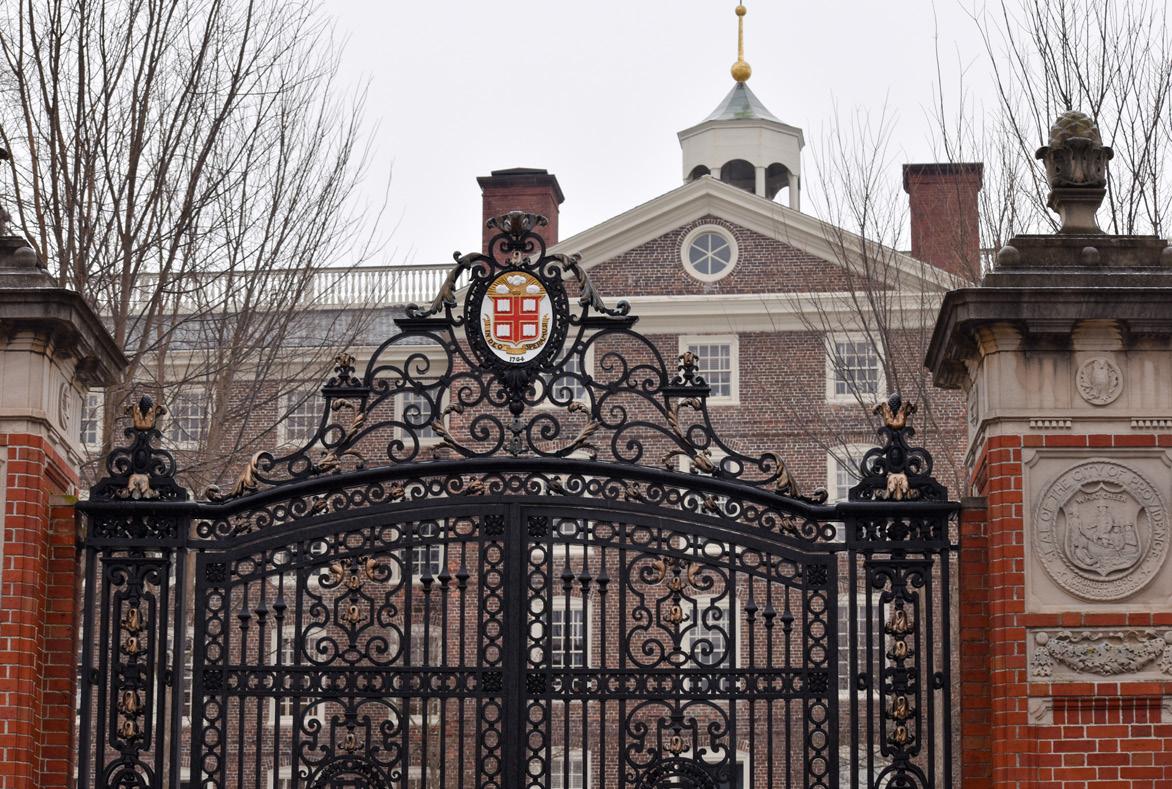
In addition to scholarships for PPSD students, the pre-college programs offer scholarships on a need-based basis for dependents of qualified University employees and for students affiliated with an organization that the University’s pre-college programs partner with.
Seppings ’25 joins Great Britain national team for World Baseball Classic
Relief pitcher previously represented nation in U18 and U23 tournaments
BY LINUS LAWRENCE SPORTS EDITORJack Seppings ’25, a relief pitcher for the baseball team, threw two scoreless eighth innings this week.
The first was this past Saturday during Brown’s 9-5 loss at the University of New Orleans.
The second was on Wednesday in Arizona against the Milwaukee Brewers, with the right-hander swapping his Bears jersey for that of the Great Britain national baseball team. In the exhibition, Seppings threw a scoreless, hitless inning against Brewers prospects, walking one batter.
Seppings was named to the team’s taxi squad for the 2023 World Baseball Classic, an international competition that began Tuesday and will conclude March 21.
Though he will not join Great Britain for their opening game against Team USA on Saturday night, Seppings will be on call to take a spot on the 28-man active roster should a player go down due to injury. He could also be swapped out for someone currently on the active roster if Great Britain advances to the next round of the WBC.
Following the conclusion of Brown’s weekend series last Sunday, Seppings returned home to Georgia, where he departed early the next day to arrive at Great Britain’s minicamp in Phoenix.
“To represent my country, it’s a big
deal for me,” Seppings told The Herald. “My dad’s British, so I’m in England two or three times a year. I have a lot of buddies there … (and) I have family there … (so) to see how proud everyone is of me on that side of the pond is unreal.”
Players can qualify to represent a World Baseball Classic team if one of their parents is from that country, according to the competition’s rules.
“I’m just proud of Jack and all the work he’s put in for it,” said Brown Head Coach Grant Achilles. “The opportunity to represent your country (on) the (biggest) stage, that’s certainly a really high honor.”
This is not the first time Seppings has represented Great Britain on the international stage: He played for the country’s U18 team in tournaments in Italy and Switzerland at ages 16 and 18, respectively, and has also represented the U23 National Team. Seppings said
he was supposed to travel to Germany last September to play in the WBC’s qualifying round, but was unable to do so after a lingering injury.
Seppings’s past experience gives him a level of familiarity with many of the members of the WBC team’s coaching staff, including Assistant Pitching Coach Connor Brooks, who was Seppings’s pitching coach in the U23 tournament. Despite missing the qualifying round, Seppings was in contact with Brooks and the coaching staff, sending the team videos and data in an effort to get on the team.
“I actually felt like I was in a better spot than where I was before my injury,” Seppings said. “It was (a matter of) making sure I’m 100% ready to go, (and) there (are) no underlying things that could keep me sidelined if I was” on the WBC gameday roster.
After arriving back on College Hill in late January, Seppings got a text from
Brooks saying that he would be reaching out to Achilles. Soon after, Seppings got a call from Brooks informing him what the conversation had been about: He was officially being invited to minicamp.
“I was ecstatic,” Seppings said. “Especially that I’ve been in this program now for four or five years, that’s the end goal. This is where I’ve always wanted to be.”
Great Britain’s WBC team includes players like Vance Worley, who pitched eight seasons in Major League Baseball, Trayce Thompson, who hit 13 home runs in 80 games for the Los Angeles Dodgers and San Diego Padres last season and Harry Ford, a Seattle Mariners minor leaguer who is ranked the number four catching prospect in baseball by MLB.com.
After Great Britain’s first unofficial team practice on Monday, Seppings was “picking their brains already … It’s like a
kid in a candy store, just trying to learn all (I) can,” he said. He also confirmed he had been added to a team group chat. “It’s pretty cool to have their contacts now,” he said. “No memes yet, but there’s some fun in there.”
Seppings also received his Great Britain jersey on Monday, complete with his last name on the back, a moment he described as “unreal.”
The reliever will reunite with the Bears Friday for the team’s weekend series against Pennsylvania State University. Seppings credited the Brown baseball staff for allowing him to compete in the tournament.
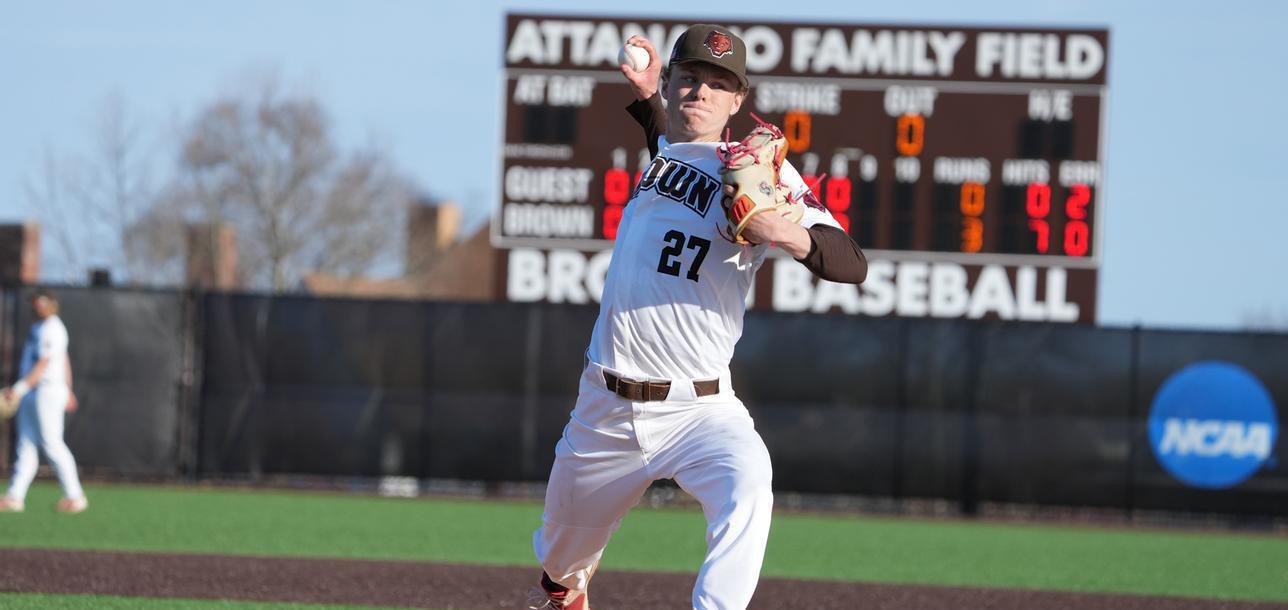
“It means a lot to me that … they trust me and my process, that I’m not slacking off … (and) that I’m doing everything I need to do to have success (in Phoenix), but also to have success on Friday.”
Teammate Ray Sass ’23 said that he told Seppings, “ ‘We’ve got your back. We don’t care if you miss a week, two weeks, a month — that’s a once-ina-lifetime thing. Go throw for them. Represent them.’ ”
“I feel like I’m representing something bigger than me,” Seppings said, noting that he feels like a “completely new pitcher” due to his time at the University. “I’m representing how we do things as a team and our process…I’m not here unless all my guys are helping me.”
As for what Seppings’s future holds with Great Britain, he did not shy away when asked if he hoped to make the team for the next World Baseball Classic, scheduled for 2026.
“That’s the dream,” Seppings said. “At the end of the day, this is what baseball is about in my mind.”
Sender ’25: Brown should explain its financial decisions
Brown University is facing what could be a serious challenge to its institutional reputation: The University, along with 16 other top universities, is being sued as part of a class action suit that could apply to 200,000 students. From 1994 until the early 2010s, Brown was part of the now-defunct 568 Presidents Group, a group named after Section 568 of the Improving America’s Schools Act of 1994, which exempted universities practicing in need-blind admissions from certain antitrust laws, allowing them to use a common financial aid methodology. The original suit alleges that nine schools, a group Brown is not a part of, did not practice truly need-blind admissions. This would invalidate the whole group’s exemption and render it an illegal cartel, or a group of market participants that sets prices together to maximize profits. Plaintiffs say that the group conspired to reduce the amount of financial aid given to students, ensuring these schools did not have to compete with one another on their aid packages.
This case is far from cut and dried, and so far a judge has ruled that the case can go forward to discovery. Regardless of its merits, valid questions about transparency lie at the heart of the case. The lack of transparency around university admissions and financial processes, including how financial aid packages are calculated and the preferential treatment donor families receive, is leaving Americans increasingly frustrated. As such, this case presents an excellent opportunity for Brown to work on restoring its relationship with students, Providence and its alumni network by introducing a far greater degree of transparency in its future dealings. It’s time for Brown to fully embrace financial transparency.
The 568 case might do that some itself: A judge recently ruled that plaintiffs can access admission and development records, including details about donations, and senior university officials will be required to sit for depositions if asked. But the University can and should go further — not just by publishing financial breakdowns like in its annual
Answers to these questions would provide students with a wealth of information currently denied to them. With an understanding of how their money is actually being put to use, students would trust the University more. This could bleed into other aspects of campus life, as students might push back less on Brown’s actions if they understood how they
a general lack of trust between Providence and the University. Even in 2012, Brown and the city were disputing basic facts regarding the payments, and there is still a lack of permanent consensus between the city and Brown. The real tragedy is there is no need for constant squabbling — Brown is dedicated to Providence, and the city values the University immensely. If Brown were willing to embrace radical transparency and show the city how it reaches the conclusions they do, it could help resolve a major source of their tension and improve a partnership that has done wonderful things for the city and will continue to.
financial report, legally required 990 forms or other documents, but by releasing a breakdown of the decision-making process behind the University’s budget. One can understand why Brown might withhold the information it does. It could allow the University to act more efficiently and protect the privacy of certain individuals in the decisions while also avoiding conflict. But the benefits in sharing information outweigh those concerns.
While the numbers that Brown already releases are useful, they do not offer any insight into why Brown would spend what it does on any given service, or why one area was prioritized over another. Even the cost calculators developed by Brown for applicants and students on financial aid provide only numbers, not the reasons for the results produced.
fit into Brown’s full decision-making process. For example, for many students, financial aid decisions are the most important consideration when choosing a college. Brown offers very generous packages to admitted students, but it is critical that students have a complete understanding of how these packages are awarded so they can be confident that they can afford four years of college and plan effectively.
Financial decision-making transparency would not only improve Brown’s relationship with its student body, but its dealings with Providence as well. Brown is currently renegotiating the payments it makes to the city in lieu of property taxes, and some are already expressing distrust and anger. This issue has long troubled the city and clearly stems from
Finally, transparency would improve relations with alums. Without clear insight into how Brown is making decisions and allocating its funds, alums may question how their donation dollars are being spent. Providing complete transparency will make alums more engaged and increase the time, energy and money they give to the University after graduation.
Brown’s annual reports are important first steps toward transparency, but it still has a lot of work to do. This should not be work that the University fears though; fully transparent operations would strengthen its key relationships. And in doing so, Brown would set a new standard as one of the first major private universities nationwide to embrace such a transparent operating procedure.
Gabe Sender ’25 can be reached at gabriel_ sender@brown.edu. Please send responses to this opinion to letters@browndailyherald. com and other op-eds to opinions@browndailyherald.com.
SINCE 1891
THE BROWN DAILY HERALD
133rd Editorial Board
Editor-in-Chief
Will Kubzansky
Managing Editors
Katy Pickens
Alex Nadirashvili
Senior Editors
Augustus Bayard
Caleb Lazar
Peter Swope
Kaitlyn Torres
Post- Magazine
Editor-in-Chief
Kimberly Liu
News
Metro Editors
Emma Gardner
Rhea Rasquinha
Jacob Smollen
Julia Vaz
Science & Research Editor

Haley Sandlow
Senior Science & Research Editor
Gabriella Vulakh
Arts & Culture Editors
Aalia Jagwani
Finn Kirkpatrick
Rya Vallabhaneni
Sports Editor Linus Lawrence
University News Editors
Sofia Barnett
Charlie Clynes
Emily Faulhaber
Grace Holleb
Sam Levine
Neil Mehta
Haley Sandlow
Kathy Wang
Digital News Director of Technology
Swetabh Changkakoti
Opinions
Editorial Page Editor
Kate Waisel
Head Opinions Editor
Alissa Simon
Opinions Editors

Anika Bahl
Bliss Han
Melissa Liu
Jackson McGough
Multimedia
Illustration Chief
Ashley Choi
Photo Chiefs
Elsa Choi-Hausman
Dana Richie
Photo Editors
Mathieu Greco
Claire Diepenbrock
Rocky Mattos-Canedo
Lilly Nguyen
Kaiolena Tacazon
Social Media Chief
Sahil Balani
Social Media Editors
Julian Beaudry
Emily Faulhaber
Kaiolena Tacazon
Production Copy Desk Chief
Brendan McMahon
Design Chief
Neil Mehta
Design Editors
Sirine Benali
Maddy Cherr
Ashley Guo
Gray Martens
Business General Managers
Joe Belfield
Andrew Willwerth
Sales Director
Alexander Zhou
Finance Director Eli Pullaro
Submissions: The Brown Daily Herald publishes submissions in the form of op-eds and letters to the Op-eds are typically between 600 and 900 words and advance a clear argument related to a topic of campus discourse. You can submit op-eds to opinions@browndailyherald.com.

Letters to the editor should be around 250 words and respond to an article or column that has appeared in The Herald, or critique or commend The Herald’s editorial decisions. You can submit letters to the editor to letters@browndailyherald.com.
Submissions undergo multiple rounds of editing. These rounds of editing generally take place over the course of one evening, and you may have to respond to edits late in the evening. If you know you will be unable to do so, please mention that in your email, and we will do our best to work with you.
Submissions can build on reporting from The Herald, reporting elsewhere, official statements from the University or other groups and other reputable sources, but they cannot break news or contain information that The Herald cannot verify. Because we cannot publish unsubstantiated information, failure to provide appropriate sources may mean we have to modify or remove unverified claims.
The Herald will not publish anonymous submissions or submissions authored by organizations. Leaders of student organizations can be identified as such but cannot write under the byline of their organization.
The Herald cannot publish all submissions it receives and reserves the right to edit all submissions. All submissions to The Herald cannot have been previously published elsewhere (in print or online — including personal blogs and social media) and must be exclusive to The Herald. Once your submission is published in The Herald, The Brown Daily Herald, Inc. owns the copyright to the materials.
Commentary: The editorial is the majority opinion of the editorial page board of The Brown Daily Herald. The editorial viewpoint does not necessarily reflect the views of The Brown Daily Herald, Inc. Columns, letters and comics reflect the opinions of their authors only.
Corrections: The Brown Daily Herald is committed to providing the Brown University community with the most accurate information possible. Corrections may be submitted up to seven calendar days after publication. Periodicals postage paid at Providence, R.I. Postmaster: Please send corrections to P.O. Box 2538, Providence, RI 02906.
Advertising: The Brown Daily Herald, Inc. reserves the right to accept or decline any advertisement at its discretion.
reserved.
“Brown’s annual reports are important first steps toward transparency, but it still has a lot of work to do.”
METRO
R.I. representatives introduce “bottle bill” for plastic-free waterways
Environmental activist groups advocate for bill under Rhode Island Zero Waste Coalition
BY MAHIN ASHFAQ SENIOR STAFF WRITEROn Thursday, Rhode Island community members gathered in the State Library, where legislators and environmental leaders spoke in support of a new “bottle bill” for the Ocean State.
In 10 states, bottle bills — which add a small tax on top of the price of a beverage to be repaid when the empty container is returned to the retailer or a redemption center for recycling — have helped keep containers, bottles and bottle caps out of bodies of water.
Save The Bay, an independent nonprofit organization that works to protect and improve Narragansett Bay, is one of several organizations in the Rhode Island Zero Waste Coalition advocating for a bottle bill to address pollution in the state.
According to Executive Director Jonathan Stone ’80, Save the Bay was founded by a small group of Rhode Island residents in response to a proposal for large-scale energy projects in Narragansett Bay, the first of which was an oil refinery in 1970. “We’ve always been a grassroots organization,” Stone said.

Save the Bay carries out their mission through three main areas of work: advocacy, education and habitat restoration and adaptation, according to their website. This advocacy involves supporting legislation to protect the bay, stopping legislation that may harm the bay and advocating for resources to clean the bay and make it more resilient to climate change, said Director of Advocacy Topher Hamblett.
“I grew up right around Narragansett Bay, I’ve been sailing there ever since I was 12 and it has always had a very special place in my heart,” said Sarah Wong ’25, a volunteer with the group. “I knew that the bay is very polluted, and Save the Bay does whatever they can to mitigate the pollution.”
The bottle bill
In January, the Rhode Island Zero Waste Coalition sent a letter to Gov. Dan McKee asking him to support a
ed the possible consequences of overturning affirmative action on Brown’s racial diversity.
“Affirmative action means that colleges and universities are at least attempting to repair U.S. schools’ disregard of Black students, teachers and curricula,” Wooten said to the crowd. “Affirmative action means more Black students have the opportunity for social mobility in a world created so we stay on the bottom.”
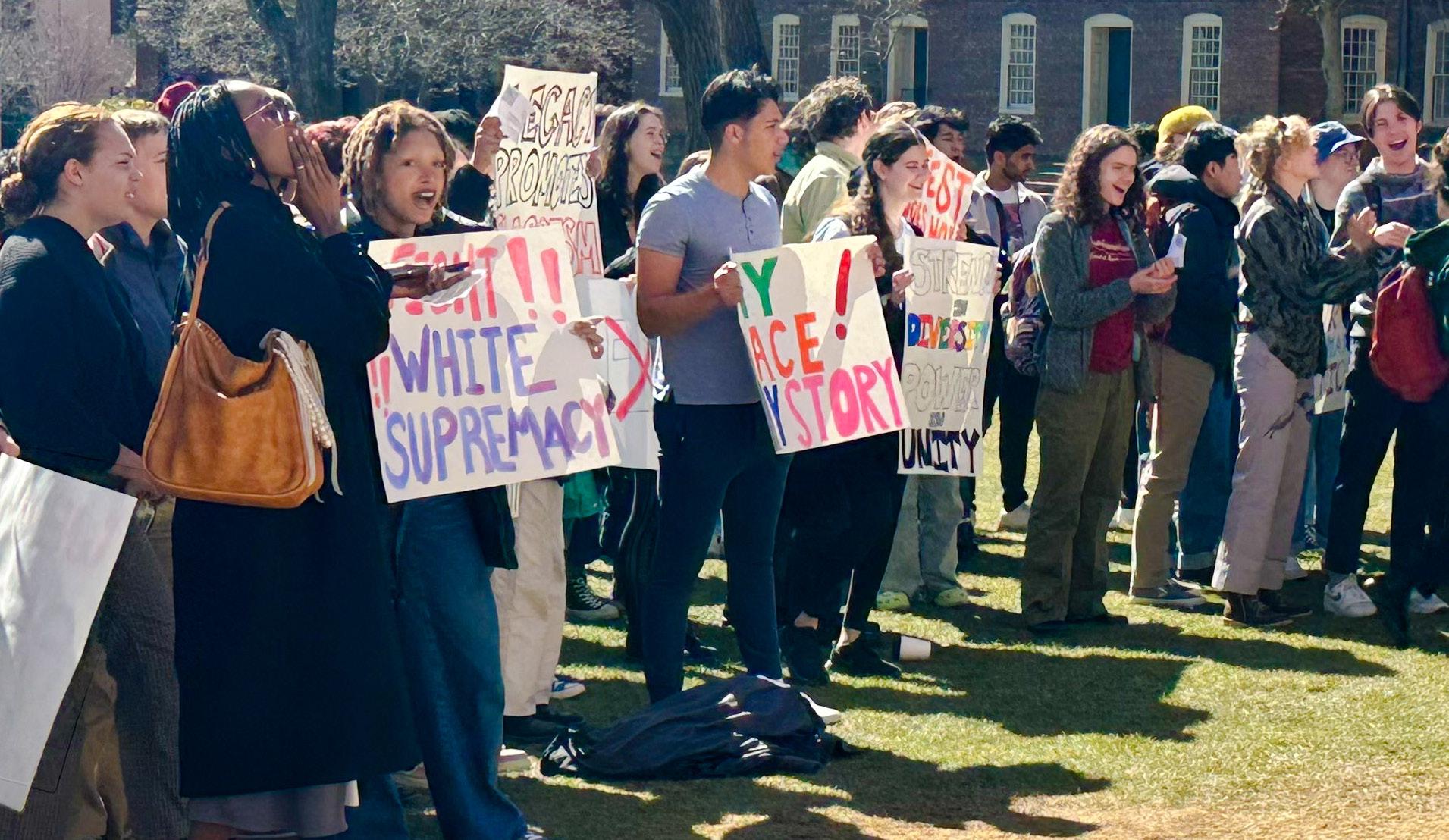
“Unfortunately, I have witnessed firsthand how repealing affirmative action means reducing the percentage of Black students and schools’ overall diversity,” Wooten added.
Wooten, who is a Michigan native, referenced her home state’s vote to ban affirmative action
bottle bill in the state.
“Keeping our state free of litter and looking pristine is a priority for the Governor,” wrote McKee’s Press Secretary Olivia DaRocha in an email to The Herald. “The Governor’s team is reviewing the legislation and we’ll continue to monitor it as it makes its way through the legislative process.”
On Feb. 10, Rep. Carol Hagan McEntee (D-Narragansett) officially introduced the Beverage Container Deposit Recycling Act of 2022. The next step is a committee hearing that will occur in the next two weeks, according to McEntee.
“We all have to be part of the solution,” she said. “The planet, it’s getting worse … plastic pollution is at the heart of it.” McEntee added that environmental groups are the “backbone” part of the Rhode Island Zero Waste Coalition. “They’re the ones who volunteer and knock on doors and pick up nips on beaches,” she said.
The R.I. legislation includes a 10cent refundable deposit on beverage containers, including small bottles known as “nips” or “shooters,” and makes provisions for both retail and independent redemption centers as return options for consumers.
“Bottle bills are the single most
at public universities, which decreased the percentage of Black students at the University of Michigan from 7% to 4% and Native American Students from 1% to 0.11%.
Skye Alex Jackson ’25, UCS chair of equity and inclusion, recalled the history of Black student activism at Brown during her speech to the crowd.
“In 1966, 65 Black students walked out in protest of Brown’s lack of commitment to students of color,” Jackson said. “They fought the administration to increase black student admission (to) over 11%.”
“It was student activism that led to the diversity we see on the campus around us,” Jackson added. “It’s student (activism) that we need now.”
effective program for recycling, for transitioning to use (and) for reducing plastics production,” said Kevin Budris, advocacy director at Just Zero, a national nonprofit that works alongside community members to promote equitable zero waste solutions.
Clean Ocean Access — an environmental non-profit organization based in Middletown — supports the bill because “plastic bottles are one of the top three items (of debris) that we do find,” said Casey Tremper, the organization’s program manager.
Three states in New England — Maine, Connecticut and Massachusetts — currently have bottle bills in place. Maryland, Illinois and Washington are among states considering a bottle bill. A study by the Container Recycling Institute on the effects of bottle bills when first implemented in U.S. states showed a consistent 70-84% reduction in beverage container litter.
Rhode Island’s plastic problem
In 2017, Save the Bay volunteers picked up 16,484 pounds of trash in a cleanup — primarily plastics.
“It gets really frustrating to see the way that plastic is building up in our environment,” said July Lewis, volunteer manager at Save the Bay.
The organization has also helped collect over 30,000 nip bottles, which usually contain 50 milliliters of alcohol, and collaborates with Friends of Saugatucket’s Great Nip Pickup Challenge, Lewis said. The Great Nip Pickup Challenge sheds light on “just how big of a problem these tiny little nip bottles are,” Lewis said.
But the waste issue is “not just the nips, it’s all kinds of other bottles and cans and containers out there,” she added.
Plastic bottles in particular are among the top three items found by Clean Ocean Access during cleanups, Tremper said.
Bottles are not just litter — they can also have serious environmental impacts. “When these plastic bottles are out on the shoreline, they are breaking down over time into little bits called microplastics” which can be ingested by marine life, Hamblett said.
In an effort to identify the presence or absence of microplastics, Mike Jarbeau, Narragansett Bay keeper at Save the Bay, conducted a microplastics project several years ago, he said. From the results, one thing was clear: Microplastics are pervasive.
“Every sample we took, no matter where we took it, contained at least
some microplastics,” Jarbeau said. “It was pretty eye-opening.”
While the full effects of microplastics are still undetermined, “when you think of the chemical components in plastic, you have to assume there are going to be long-term effects,” Jarbeau said.
Beyond microplastics, some effects of other plastic pollution are plainly visible, including plastics “wrapped around (animals’) necks,” he added.
Opposition to bottle bills, hopes for progress
According to Jed Thorp, Rhode Island state director for the grassroots environmental advocacy group Clean Water Action, major opposition to bottle bills typically comes from beverage companies.
“We are open to solutions that are designed to effectively recover more of our bottles and cans so they can be remade into new ones, as intended,” wrote a spokesperson for the American Beverage Association in an email to The Herald. “Our decades of experience working within deposit systems shows they work best when funded and run by private sector producers of recyclable materials, ensuring high recycling rates, financial stability and convenience to consumers.”
But Budris noted that a private sector-run recycling program “would be a mistake for Rhode Islanders.”
The implementation of the bottle bill is “still … an uphill battle, as we’ve got to calm a lot of fears,” McEntee said.
Polling data for states that have bottle bills show that “the public in those states has a pretty favorable opinion of those systems,” Thorp said. “People get used to returning the empties.”
“Everyone I’ve talked to has also been supportive of it,” said Connecticut resident Elizabeth Ellenwood, who attended the State House rally. “I think we all can do a better job of thinking about waste management and what we need as materials in our lives.”
Ellenwood attended Thursday’s rally because “it’s the neighboring spot that I’m concerned about,” she said. “The water … touches both states.”
“Advocates want it, lawmakers want it, Rhode Island residents want it (and) we feel good about it this year,” Budris said.
on collegiate athletes’ compensation that the Supreme Court unanimously struck down in Alston,” the complaint reads.
The plaintiffs are being represented by a team including Robert Litan from Berger Montague, a pioneering class action law firm. In 2021, Litan wrote an article for The New Republic claiming that the Ivy League has been allowed to operate like a “monopoly,” which disproportionately harms potential student athletes who are students of color.
“Congress and the executive branch have allowed the eight colleges belonging to the Ivy League to circumvent antitrust laws by apparently agreeing to limit the amount of aid deserving students
can receive,” he wrote.

In an interview with The Herald, Litan said he and the other attorneys were approached by the plaintiffs. Due to their background, Litan said that his team were “logical people to be bringing this case” to.
According to Litan, the case is based on two main legal theories, both connected to unlawful price-fixing schemes. The first relates to the fact that the eight Ivy League schools are the only Division I schools to not provide athletic scholarships. By only providing need-based financial aid, Litan said that the schools are limiting the amount of education-related benefits available to student athletes, in direct violation of the 2021 Alston case.
The second theory is that the




Ivy League “has limited to zero the compensation for athletic services,” he said. Since financial aid is just as available for non-athlete students, “the athletes are getting nothing extra for providing their services to the schools,” nor receiving compensation for the revenue they bring in, Litan explained.
“It’s pretty simple,” he said. “It just basically extrapolates the reasoning of Alston to say that the Ivy League should be treated just like the” National Collegiate Athletic Association.
McCann believes one possible defense from the Ivy League will be that student athletes “are not a ‘market’ for purposes of antitrust scrutiny — namely, athletes who might go to Harvard or Dartmouth can instead go to other academical -
ly elite colleges with similar sports profiles where athletic scholarships are offered,” he wrote.
McCann also highlighted how the lawsuit will likely not impact the schools’ individual decisions on whether to offer athletic scholarships. “If Brown on its own, or Yale on its own, didn’t want to give athletic scholarships to their athletes, that is fine under antitrust law,” he wrote. “The problem is when two or more colleges … agree to not give scholarships.”
As it stands, “the complaint has no merit,” University Spokesperson
Brian Clark wrote in an email to The Herald. “Brown’s undergraduate financial aid program is (one of) the most robust among all U.S. colleges and universities, and meets 100% of each Brown undergradu -
ate’s demonstrated financial need.”



“If (the University is) served with this complaint directly, we will conduct a full review and respond as appropriate through the legal process,” he added.
While McCann believes it is too early to draw conclusions, he wrote that “the case makes plausible and seemingly persuasive arguments.”
The plaintiffs’ are seeking treble damages for all class members, including current and former Ivy League athletes recruited since March 2019, beyond any relief deemed necessary by the Court.
The complaint also instates “a permanent injunction” prohibiting the Ivy League to continue its alleged agreement or engage in “any equivalent horizontal agreement, combination or conspiracy.”
answer — “What is the Eiffel Tower?” — to the Final Jeopardy! question, as well as a sizable bet.



“I was in a place where I had to bet everything, so it was basically all riding on me being able to get that last question,” Bolsen said.
“When I saw the clue pop up, I was like, ‘I know this,’ and it started coursing through my mind. I knew I couldn’t show excitement on my face, but that’s when I knew it was over.”
Bolsen had to be “super aggressive with betting (his) money” in order to win, which he said is a different approach from most contestants, who “are conservative in wagering because they don’t want to lose their money.”
“I just throw everything out there,” Bolsen said. “And it worked well.”





According to Caleb Richmond, a tournament semi-finalist and Georgetown University sophomore, “Justin is a strong and confident competitor who’s not afraid to bet
big and doesn’t show stress in the high-pressure studio environment.”
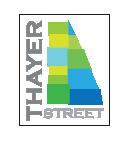
“I’ve never played directly against him, and I consider myself lucky for that,” Richmond added.
“He is such a strong competitor,” said Jones, who placed second in the tournament.

“He’s ridiculously smart, fast on the buzzer and he’s always calm during the game,” he added.
“Competing against him is honestly intimidating, but it’s nice competing against someone I consider a good friend.”
According to Bolsen, competing on Jeopardy! “is like blacking out.”
“I don’t remember anything,” he said. “When I’m watching tonight’s episode, I’ll be remembering the stuff that happened in the game as everyone else sees it.”
For Bolsen, who receives financial aid from the University, winning the $100,000 prize “is a huge deal.”




“It’s more money than my household makes in a year,” he said.
“The money doesn’t feel real right now, but I’m sure when I actually receive it and start to deal with
it, things will be different.”
At the end of the day, Bolsen “feels so incredibly lucky (and) excited” about his victory.
Richmond told The Herald he admires Bolsen for his “strong balance between confidence and humility.”
“Over the past four years, I’ve been lucky to be his friend,” he added.


“Knowing Justin, he won’t let Jeopardy! go to his head and he’ll continue to be humble, caring and kind.”
In the second episode of The Bruno Brief’s series on myths at Brown, Producer Sonya McNatt speaks with Finn Kirkpatrick, Arts & Culture editor and Bruno Brief editor, about his reporting on the now closed-off tunnels that run underneath Brown’s campus and Providence. What’s the deal with these tunnels? What are their histories? And what’s their status today?
Subscribe to the podcast on Spotify or Apple Podcasts or listen via the RSS feed. The Bruno Brief is produced in partnership with WBRU.
